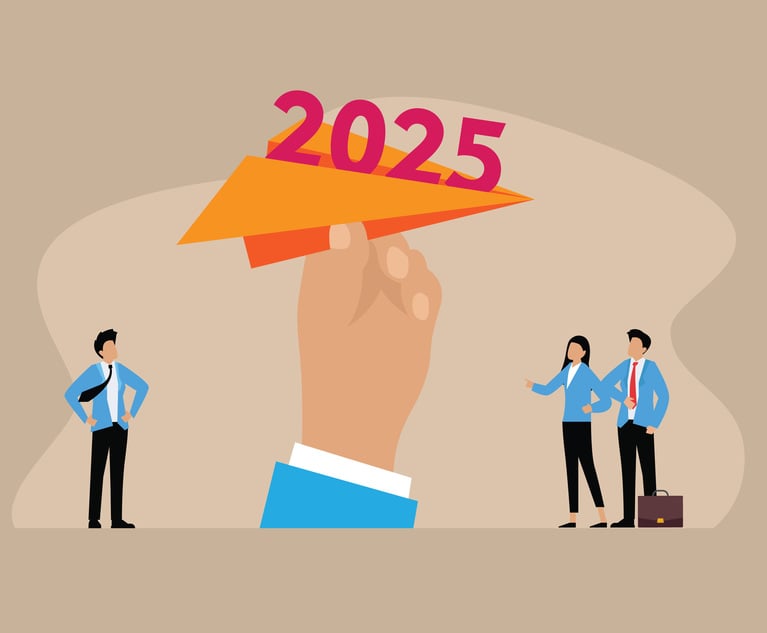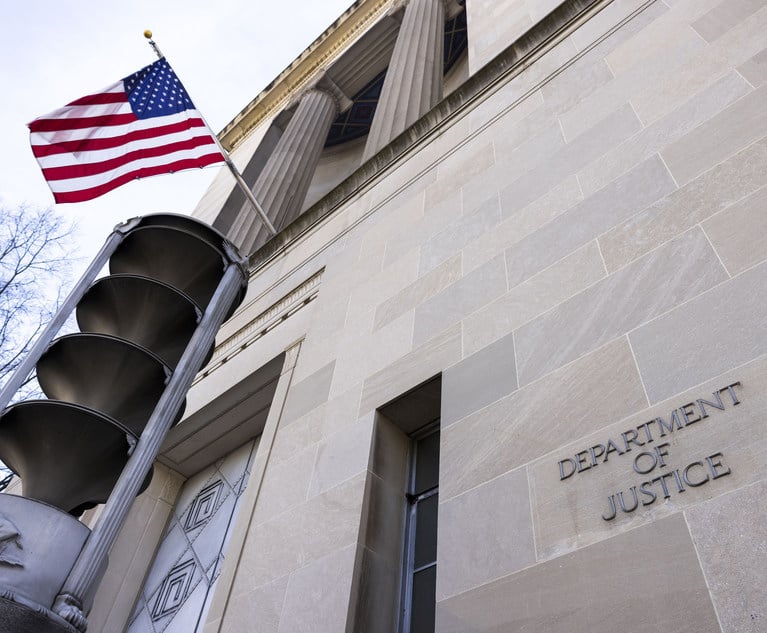 A view of the New York Stock Exchange on the corner of Wall St. and Nassau St. Photo: Ryland West/ALM
A view of the New York Stock Exchange on the corner of Wall St. and Nassau St. Photo: Ryland West/ALM Wall Street Warns Wishful Thinking Won't End Bear Market
Recent events in the U.K. and Australia suggest monetary officials will have to weigh their hawkish impulses against risks to economic and financial stability.
October 06, 2022 at 01:10 PM
4 minute read
Dip buyers wagering that the era of central-bank hawkishness has peaked got a reminder that they are playing a dangerous game.
The S&P 500 sank as much as 1.8% after the biggest two-day surge since April 2020 drew in traders tanked up on newly dovish monetary bets. While the index clawed back most of the losses to close 0.2% lower, would-be bulls were put on notice as Federal Reserve Bank of San Francisco President Mary Daly disabused notions that a policy pivot is in the offing.
Yes, recent events in the U.K. and Australia suggest monetary officials will have to weigh their hawkish impulses against risks to economic and financial stability. Yet with nothing short of policy credibility at stake given price pressures remain at decade highs, the Fed looks all set to press on with its most aggressive tightening campaign in recent memory.
That suggests inflation-adjusted yields on 10-year Treasuries could easily break out again, pummeling rate-sensitive risk assets anew from credit to equities.
"We've been struggling with this idea that markets are pricing a fast pivot from the Fed next year," said Christian Mueller-Glissmann, head of asset allocation research at Goldman Sachs Group Inc., who correctly warned that real yields would turn positive this year, bringing with them bear markets. "We see the Fed continue to hike into next year so it might be too early to expect long-dated real yields to peak on sustained basis."
Hopes that central banks are ready to back down from aggressive tightening campaigns intensified after a dovish surprise from Australia's central bank and bond-buying plans by the Bank of England. This took the S&P 500 and the tech-heavy Nasdaq 100 higher by more than 3% on Tuesday as traders pricing in rate cuts in 2023 fueled a giddy rebound in key indexes at the start of the fourth quarter following the longest string of losses since 2009.
A Goldman Sachs Group Inc. basket of nonprofitable tech firms rallied as much as 8% on Tuesday after shaving more than half its value in the first nine months of this year amid a massive rate-induced valuation correction.
The recent risk appetite runs counter to the hawkish missives lobbed by Fed officials on a seemingly daily basis, talking up their steely resolve to crush elevated price pressures. The central bank's own dot plot forecast suggests the hiking cycle will see rates moving to 4.6% in 2023, compared with the current benchmark rate at around 3.25%.
Fed Chair Jerome "Powell has been clear that the Fed does not intend to pivot until the path to lower inflation in clear," said Ed Clissold, the chief U.S. strategist at Ned Davis, who is neutral on U.S. shares, favoring small-cap companies over large. "The market should remain volatile in reaction to economic data points and Fed Speak."
Meanwhile market-implied inflation expectations over the next two years have tumbled from as high as 4.9% in March to around 2.3%, implying traders reckon price pressures will fall closer to the Fed's target, clearing the path for a dovish policy pivot, in theory.
Yet those expectations are too benign, says Goldman's Mueller-Glissmann. And it wouldn't be the first time hopes for peak inflation have been disappointed. The U.S. consumer price index climbed by a more than forecast 8.3% in August from a year earlier, wrong-footing many in the market. The Fed's preferred inflation metric, core PCE data, also exceeded predictions last week.
Friday's jobs data and the latest consumer price report due next week will give fresh clues on how much room the Fed has to tighten the monetary screw without materially damaging the U.S. business cycle.
Risk bulls may have seized on a seemingly newfound acknowledgment from U.S. monetary officials that the global economic landscape is darkening and that the Fed is attuned to the negative spillovers. Yet any resulting damage to the U.S. economy would be the proximate cause for a tentative shift in its rate-hiking campaign, a scenario that some market watchers say is bad for all types of investors.
"Things need to get worse before they get better or before we see a Fed pivot," said Christopher Harvey, head of equity strategy at Wells Fargo.
Denitsa Tsekova reports for Bloomberg News.
NOT FOR REPRINT
© 2025 ALM Global, LLC, All Rights Reserved. Request academic re-use from www.copyright.com. All other uses, submit a request to [email protected]. For more information visit Asset & Logo Licensing.
You Might Like
View All
Special Counsel Jack Smith Prepares Final Report as Trump Opposes Its Release
4 minute read
These Law Firm Leaders Are Optimistic About 2025, Citing Deal Pipeline, International Business
6 minute read
'Serious Disruptions'?: Federal Courts Brace for Government Shutdown Threat
3 minute read
Government Attorneys Are Flooding the Job Market, But Is There Room in Big Law?
4 minute readTrending Stories
- 1NASDAQ Beats Back Investor Claims of Bias Against Minority-Owned Businesses
- 2Former Google Legal Exec Joins Ad Tech Unicorn as GC
- 3Fenwick and Baker & Hostetler Add DC Partners, as Venable and Brownstein Hire Policy Advisers
- 4H&R Block Accused of Negligence in Data Breach Suit
- 5Apple Disputes 'Efforts to Manufacture' Imaging Sensor Claims Against iPhone 15 Technology
Who Got The Work
Michael G. Bongiorno, Andrew Scott Dulberg and Elizabeth E. Driscoll from Wilmer Cutler Pickering Hale and Dorr have stepped in to represent Symbotic Inc., an A.I.-enabled technology platform that focuses on increasing supply chain efficiency, and other defendants in a pending shareholder derivative lawsuit. The case, filed Oct. 2 in Massachusetts District Court by the Brown Law Firm on behalf of Stephen Austen, accuses certain officers and directors of misleading investors in regard to Symbotic's potential for margin growth by failing to disclose that the company was not equipped to timely deploy its systems or manage expenses through project delays. The case, assigned to U.S. District Judge Nathaniel M. Gorton, is 1:24-cv-12522, Austen v. Cohen et al.
Who Got The Work
Edmund Polubinski and Marie Killmond of Davis Polk & Wardwell have entered appearances for data platform software development company MongoDB and other defendants in a pending shareholder derivative lawsuit. The action, filed Oct. 7 in New York Southern District Court by the Brown Law Firm, accuses the company's directors and/or officers of falsely expressing confidence in the company’s restructuring of its sales incentive plan and downplaying the severity of decreases in its upfront commitments. The case is 1:24-cv-07594, Roy v. Ittycheria et al.
Who Got The Work
Amy O. Bruchs and Kurt F. Ellison of Michael Best & Friedrich have entered appearances for Epic Systems Corp. in a pending employment discrimination lawsuit. The suit was filed Sept. 7 in Wisconsin Western District Court by Levine Eisberner LLC and Siri & Glimstad on behalf of a project manager who claims that he was wrongfully terminated after applying for a religious exemption to the defendant's COVID-19 vaccine mandate. The case, assigned to U.S. Magistrate Judge Anita Marie Boor, is 3:24-cv-00630, Secker, Nathan v. Epic Systems Corporation.
Who Got The Work
David X. Sullivan, Thomas J. Finn and Gregory A. Hall from McCarter & English have entered appearances for Sunrun Installation Services in a pending civil rights lawsuit. The complaint was filed Sept. 4 in Connecticut District Court by attorney Robert M. Berke on behalf of former employee George Edward Steins, who was arrested and charged with employing an unregistered home improvement salesperson. The complaint alleges that had Sunrun informed the Connecticut Department of Consumer Protection that the plaintiff's employment had ended in 2017 and that he no longer held Sunrun's home improvement contractor license, he would not have been hit with charges, which were dismissed in May 2024. The case, assigned to U.S. District Judge Jeffrey A. Meyer, is 3:24-cv-01423, Steins v. Sunrun, Inc. et al.
Who Got The Work
Greenberg Traurig shareholder Joshua L. Raskin has entered an appearance for boohoo.com UK Ltd. in a pending patent infringement lawsuit. The suit, filed Sept. 3 in Texas Eastern District Court by Rozier Hardt McDonough on behalf of Alto Dynamics, asserts five patents related to an online shopping platform. The case, assigned to U.S. District Judge Rodney Gilstrap, is 2:24-cv-00719, Alto Dynamics, LLC v. boohoo.com UK Limited.
Featured Firms
Law Offices of Gary Martin Hays & Associates, P.C.
(470) 294-1674
Law Offices of Mark E. Salomone
(857) 444-6468
Smith & Hassler
(713) 739-1250






